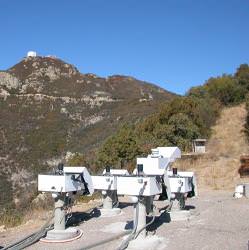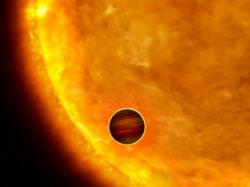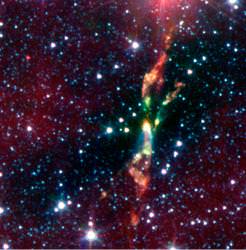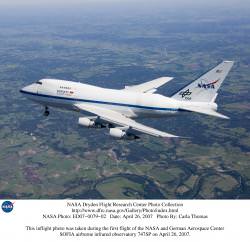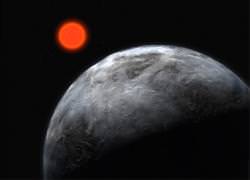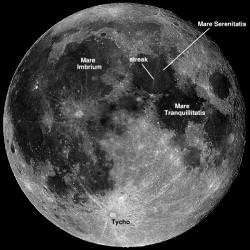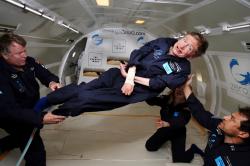Monday, April 30 – Karl Frederich Gauss was born on this day in 1777. Known as the “Prince of Mathematics,” Gauss contributed to the field of astronomy in many ways – from computing asteroid orbits to inventing the heliotrope. Out of Gauss’ many endeavors, he is most recognized for his work in magnetism. We understand the term “gauss” as a magnetic unit – a refrigerator magnet carries about 100 gauss while an average sunspot might go up to 4000. On the most extreme ends of the magnetic scale, the Earth produces about 0.5 gauss at its poles, while a magnetar can produce as much as 10 to the 15th power in gauss units!
While we cannot directly observe a magnetar, those living in the Southern Hemisphere can view a region of the sky where magnetars are known to exist – the Large Magellanic Cloud – or you can use the projection method to view a sunspot! If you have a proper solar filter, magnetism distorts sunspots as they near the limb – called the “Wilson Effect”
While both magnetars and sunspots are areas of awesome magnetic energy, what happens when you find magnetism in a very unlikely place? Tonight have a look at the lunar surface just a little southeast of the grey oval of Grimaldi. The area we are looking for is called the Sirsalis Rille and on an orb devoid of magnetic fields – it’s magnetic! Like a dry river bed, this ancient “crack” on the surface runs 480 kilometers along the surface and branches in many areas. Be sure to look for Spica nearby!
Tuesday, May 1 – On this day in 1949 Gerard Kuiper discovered Nereid, a satellite of Neptune. If you’re game, you can find Neptune about two fingerwidths northeast of Gamma Capricorni about an hour before dawn. While it can be seen in binoculars as a bluish “star,” it takes around a 6″ telescope and some magnification to resolve its disc. Today’s imaging technology can even reveal its moons!
While you’re out this morning, keep an eye on the sky for the peak of the Phi Bootid meteor shower, whose radiant is near the constellation of Hercules. While the best time to view a meteor shower is around 2:00 a.m. local time, you will have best success watching for these meteors when the Moon is as far west as possible. The average fall rate is about 6 per hour.
This is the beginning of Astronomy Week for amateurs the world over. While the Moon is incredibly near full, it will still be an awesome sight for those who have never seen it through a telescope. Invite someone to visit with you, or offer to take your telescope to a public area. Power up on bright features like Tycho’s rays, it’s an inspiring sight!
Another great target for a bright night is Delta Corvi. 125 light-years away, it displays a yellowish color primary and slightly blue secondary that’s an easily split star in any telescope, and a nice visual double with Eta in binoculars. Use low power and see if you can frame this bright grouping of stars in the same eyepiece field.
Wednesday, May 2 – Tonight is Full Moon. By May in most areas, flowers are everywhere, so it’s not hard to imagine how this became to be known as the “Full Flower Moon.” Since the Earth is awakening again, agriculture has re-emerged and so it is sometimes known as the “Full Corn Planting Moon,” or the “Milk Moon.” No matter what you call it, it’s still majestic to watch rise!
To participate in another lunar club challenge and do some outreach work, you can demonstrate the “Moon Illusion” to someone. While we know it’s purely psychological and not physical – the fact remains that the Moon seems larger on the horizon. Using a small coin held at arm’s length, compare it to Luna as it rises, and then again as it seems to “shrink” as it gets higher! You’ve now qualified for extra credit…
Even though the Moon is very bright when full, try using colored or Moon filters to have a look at the many surface features which throw amazing patterns across its surface. If you have none, a pair of sunglasses will suffice. Look for things you might not ordinarily notice – such as the huge streak which emanates from crater Menelaus. Look at the pattern projected from Proclus – or the intense little dot of little-known Pytheas north of Copernicus. It’s hard to miss the blinding beacon of Aristarchus! Check the southeastern limb where the edge of Furnerius lights up the landscape…or how a nothing crater like Censorinus shines on the southeast shore of Tranquillitatis, while Dionysus echoes it on the southwest. Could you believe Manlius just north of central could be such a perfect ring – or that Anaxagoras would look like a northern polar cap?
While it might be tempting to curse the Moon for hiding the stars when it’s full, there is no other world out there that we can view in such detail… Even if you just look with your eyes!
Thursday, May 3 – With just a little bit of time before the Moon rises, let’s take a look at the constellation of Leo and its brightest stars. For our first destination we’ll travel 85 light-years to learn about “The Little King” – Regulus.
Ranking as the twenty-first brightest star in the night sky, 1.35 magnitude Alpha Leonis is a helium type star about 5 times larger and 160 times brighter than our own Sun. Speeding away from us at 3.7 kilometers per second, Regulus is also a multiple system whose 8th magnitude companion is easily seen in small telescopes. The companion is itself a double at around magnitude 13 and is a dwarf of an uncertain type. There is also a 13th magnitude fourth star in this grouping, but it is believed that it is not associated with Regulus since the “Little King” is moving toward it and will be about 14″ away in 785 years.
Northeast of Regulus by about a fistwidth is 2.61 magnitude Gamma Leonis – also known as Algieba. This is one of the finest double stars in the sky, but a little difficult at low power since the pair is both bright and close. Separated by about twice the diameter of our own solar system, this 90 light-year distant pair is slowly widening.
Another two fingerwidths north is 3.44 magnitude Zeta – also named Aldhafera. Located about 130 light-years away, this excellent star has an optical companion which is viewable in binoculars – 35 Leonis. Remember this pair, because it will lead you to galaxies later!
Before we leave, let’s have a look east at 3.34 magnitude Theta. Also known as Chort, mark this one in your memory, as well as 3.94 magnitude Iota to the south as markers for a galaxy hop. Last is easternmost 2.14 magnitude Beta. Denebola is the “Lion’s Tail” and has several faint optical companions.
Friday, May 4 – Tonight there will be a short while for us to enjoy a galaxy hop before the Moon interferes. Using our knowledge of Leo, this galaxy pair is relatively easy for larger binoculars and small telescopes. You’ll find them almost perfectly mid-way between Theta and Iota and their names are M65 and M66.
Discovered by Méchain in March 1780, apparently Mr. Messier didn’t notice the bright pair when a comet passed between them in 1773. At around 35 million light-years away, you will find M66 to be slightly brighter than its 200,000 light-year distant western neighbor – M65. While both are Sb classed spirals, the two couldn’t appear more different. M65 has a bright nucleus and a smooth spiral structure with a dark dustlane at its eastern edge. M66 has a more stellar core region with thick, bright arms that show knots to larger scopes – as well as a wonderful extension from the southern edge.
If you are viewing with a larger scope, you may notice to the north of this famous pair yet another galaxy! NGC 3628 is a similar magnitude edge-on beauty with a great dissecting dark dustlane. This pencil-slim, low surface brightness galaxy is a bit of a challenge for smaller scopes, but larger ones will find its warped central disc well worth high power study.
Congratulations on spotting the “Leo Trio” and a member of the Arp’s Peculiar Galaxy Catalog! Now be sure to watch as the Moon rises bringing with it Antares a half degree away. Be sure to check IOTA for possible occultations!
Saturday, May 5 – In 1961 Alan Shepard became the first American in “space” (as we now refer to that region above the sky), taking a 15 minute suborbital ride aboard the Mercury craft Freedom 7.
Tonight let’s head for another trio of galaxies that are suited best for mid-to-large aperture telescopes. Begin by heading west about a fistwidth from Regulus and identify 52 Leonis. Our mark is one and a half degrees south. At lower power you will see a triangle of galaxies.
The largest and brightest is M105, discovered by Méchain on March 24, 1781. This dense elliptical galaxy would appear to be evenly distributed, but the Hubble Space Telescope revealed a huge area within its core to be equal to about 50 million solar masses. The companion elliptical to the northeast – NGC 3384 – will reveal a bright nucleus as well as an elongated form. The faintest of this group – NGC 3389 – is a receding spiral and for larger scopes will reveal “patchiness” in structure.
Continue another degree south and enjoy another galactic pair. The widely spaced M96 and M95 are part of the galaxy grouping known as Leo I. The dusty spiral – M96 – will appear as a silver oval, whose nucleus is much sharper than its faint spiral arms. M96 hosted a supernova as recently as 1998. To its west, you will discover one very beautiful barred spiral – M95. While both of these were discovered by Méchain only four days earlier than M105, it wasn’t until recent years that they became a prime target of the Hubble Space Telescope. We enjoy M95 for its unique ring-like arms and unmistakable barred core, but the HST was looking for Cepheid variables to help determine the Hubble Constant. While we don’t need a space telescope to view this group of galaxies, we can now appreciate knowing that we can see 38 million light-years away from our own backyard!
If you’re still out when the Moon rises, be sure to look for Jupiter about a fistwidth away.
Sunday, May 6 – For those who like curiosities, our target for tonight will be 1.4 degrees northwest of 59 Leonis, which is itself about a degree southwest of Xi. While this type of observation may not be for everyone, what we are looking for is a very special star – a red dwarf named Wolf 359 (RA 10 56 28.99 Dec +07 00 52.0). Although it is faint at approximately 13th magnitude, you will find it precisely at the center of the highly accurate half degree field photo below.
Discovered photographically by Max Wolf in 1959, charts from that time period will no longer be accurate because of the star’s large proper motion. It is one of the least luminous stars known, and we probably wouldn’t even know it was there except for the fact that it is the third closest star to our solar system. Located only 7.5 light-years away, this miniature star is about 8% the size of our Sun – making it roughly the size of Jupiter. Oddly enough, it is also a “flare star” – capable of jumping another magnitude brighter at random intervals.
It might be faint and difficult to spot in mid-sized scopes, but Wolf 359 is definitely one of the most unusual things you will ever observe!


